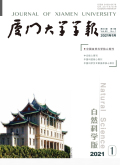厦门大学学报(自然科学版)2024,Vol.63Issue(5):850-866,17.DOI:10.6043/j.issn.0438-0479.202401026
视网膜再生中调控Müller细胞重编程的表观遗传修饰和微环境因素研究进展
Research progress in epigenetic and microenvironment factors affecting Müller glia reprogramming in retinal regeneration
摘要
Abstract
[Background]Multiple retinal diseases,including diabetic retinopathy,age-related macular degeneration,retinitis pigmentosa,and glaucoma,cause irreversible vision loss in patients and currently lack effective therapies.In recent years,with the development of both theories and technologies,novel therapies based on exogenous stem cells transplantation or endogenous stem cells have raised hope for people who are blind.Although endogenous stem cells have not be identified in the adult retina,Müller glia(MG)have been found to possess the ability/potential to regenerate retinal neurons.Specifically,zebrafish(Danio rerio)MG could follow three steps,including proliferate,reprogram into progenitor cells,and differentiate into retinal neurons,to regenerate lost neurons after injury.However,mammalian MG only transiently express the cell cycle and progenitor cell markers after injury,quickly exiting the cell cycle to enter reactive gliosis,ultimately forming retinal scars.Based on these findings,a critical approach to curing blinding retinal diseases is to reignite the regeneration capabilities of mammalian MG.[Progress]Through in-depth analysis of the regeneration molecular program of zebrafish MG and detailed comparisons between zebrafish and mammalian MG,multiple transcription factors have been identified to affect the regenerative abilities of MG.Accordingly,scientists have been able to use a combination of transcription factors to reprogram mammalian MG into retinal neuron-like cells in vitro and in vivo.In addition to transcription factors,cell fate could be affected by epigenetic and microenvironment factors.Thus,in this paper we review recent research progress in these two areas.At the epigenetic level,although the reduction of DNA methylation could facilitate the reprogramming of MG at the early stage,the proliferation and migration of MG derived progenitor cells(MGPCs)might require de novo DNA methylation at the promoter regions of some critical genes.Additionally,histone acetylation is important for the formation of MGPCs in zebrafish,and the inhibitors of histone deacetylases could help mouse MG regenerate neuron-like cells when Ascl1 is overexpressed in these MG.Moreover,several studies demonstrated that chromatin remodeling complexes and multiple non-coding RNAs could affect the regenerative abilities of MG in both zebrafish and mammals.At the microenvironment level,multiple cell types in the retina,including MG themselves,microglia/infiltrated macrophages,vascular endothelial cells and retinal pigment epithelium,could crosstalk with MG to affect retinal regeneration.Specifically,these cells might use growth factors,inflammatory cytokines,secreted matrix metalloproteinases,and vesicles/exosomes to communicate necessary information and facilitate regeneration of retinal neurons from MG.[Perspective]With the advance of next-generation sequencing and gene manipulation technologies,the regeneration of photoreceptor-and retinal-ganglion-like cells from MG has been achieved in mice,bringing hope to restoring vision in the blind.As there are three consecutive steps to regenerate retinal neurons from MG in zebrafish,the molecular program underlying this regeneration process is quite complex.Thus,other than transcription factors and signaling pathways,the manipulation of epigenetic program and retinal microenvironment should also have a fundamental influence on MG mediated retinal regeneration.As a result,harmony and cooperative regulation among extracellular environment,intracellular signal transduction,epigenetic modifications and transcriptional controls in the nucleus are necessary to eventually regenerate mature retinal neurons and integrate these newly regenerated neurons into the neural circuits in mammals.In addition to transgenic methods,using"cocktails therapy"comprised of small molecular chemicals could be an alternative way to promote the regeneration of retinal neurons from MG in mammals.The further development of basic research in retinal development,comparative studies of MG-mediated retinal regeneration across various organisms,genetic tools,and chemical"cocktails therapy"will facilitate clinical translation and ultimately restore vision in patients.关键词
Müller细胞/视网膜再生/表观遗传修饰/微环境Key words
Müller glia/retinal regeneration/epigenetic/microenvironment分类
临床医学引用本文复制引用
廖怿,何婉玲..视网膜再生中调控Müller细胞重编程的表观遗传修饰和微环境因素研究进展[J].厦门大学学报(自然科学版),2024,63(5):850-866,17.基金项目
厦门市自然科学基金(3502Z202373024) (3502Z202373024)

